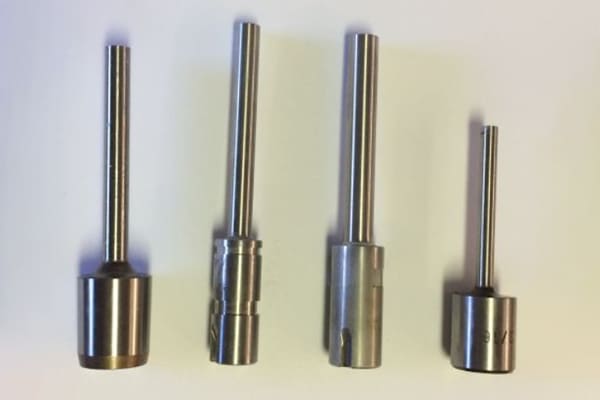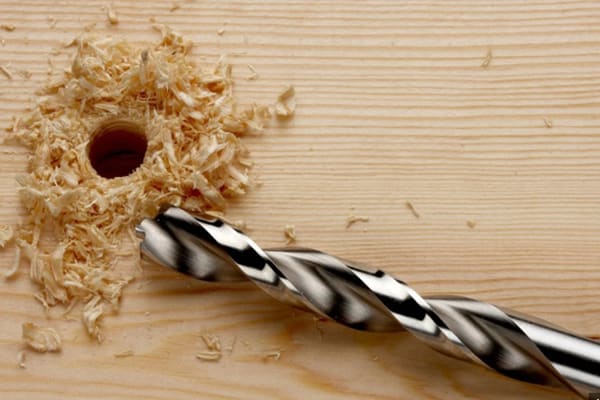Working with concrete can be a real challenge, especially when you need to drill precise holes. This article will guide you through the world of hollow drill bits, focusing on SDS and hollow drill bit FHD types, to help you choose the right drill bit for your concrete projects. Understanding the differences between these concrete drill bit options, like those offered by Bosch, will make your work faster, cleaner, and more efficient.
1. What is a Drill Bit and Why Choose a Hollow Drill Bit for Concrete?
At its most basic, a drill bit is a tool designed to create holes in various materials. Think of it as the sharp point that does the actual drilling. When it comes to tough materials like concrete, choosing the right drill bit is crucial for efficiency and the longevity of your drill. A hollow drill bit, unlike a solid one, has a central channel running through its length. The primary reason to choose a hollow drill bit for concrete is its ability to remove drill dust directly from the hole as you drill. This feature offers several advantages, making the drilling process cleaner, faster, and more precise, especially when working with concrete.
Traditional concrete drill bits grind away at the material, creating a significant amount of dust. This dust can obscure your view, slow down the drilling speed, and even pose health hazards. A hollow drill bit, often tipped with tough carbide, tackles this challenge head-on. By providing a pathway for dust to escape, it allows the drill bit to cut more efficiently and maintain consistent contact with the concrete. This is particularly beneficial when drilling deeper holes or working in sensitive environments where minimizing dust is important.
2. Understanding SDS and SDS Max: What's the Difference and When to Use Which?
You'll often encounter the terms SDS and SDS Max when looking at hammer drill bits, especially for concrete. SDS, which stands for Slotted Drive System, refers to the shank design of the drill bit. This special shank allows the drill bit to move slightly back and forth within the drill chuck, providing the hammering action necessary for effectively breaking up concrete and masonry. SDS Plus is the most common SDS type you'll find, suitable for a wide range of drilling tasks in concrete, brick, and other masonry materials. It's a versatile option for general construction and DIY projects.
SDS Max, on the other hand, is a heavier-duty version of SDS. SDS Max drill bits have a larger shank and are designed for more powerful hammer drills. They are used for larger diameter holes and more demanding drilling applications in concrete, including reinforced concrete. Choosing between SDS Plus and SDS Max depends on the power of your drill and the size of the hole you need to drill. For smaller holes and lighter tasks, SDS Plus is sufficient. For larger holes and tougher concrete, SDS Max is the way to go. Many Bosch concrete drill bits are available in both SDS Plus and SDS Max versions.
3. What Makes a Hollow Drill Bit Different from a Standard Concrete Drill Bit?
The most obvious difference between a hollow drill bit and a standard concrete drill bit is the central hole running through the hollow drill bit. A standard concrete drill bit is typically solid, relying on flutes (the spiral grooves along the side) to remove debris from the drill hole. While effective for general drilling, this method can be less efficient when dealing with the fine dust produced by drilling concrete. The accumulation of dust in the hole can increase friction, slow down the drilling speed, and cause the drill bit to overheat and wear out faster.
A hollow drill bit addresses this issue by providing a dedicated channel for dust extraction. This allows for a much cleaner drilling process. The dust is drawn away from the drill tip as you work, preventing it from clogging the hole and allowing the drill bit to cut more aggressively. This difference in design leads to several benefits, including faster drilling speeds, reduced wear on the drill bit, and a cleaner working environment. Think of it like a vacuum cleaner working simultaneously as you drill.

4. The Challenge of Dust When Drilling Concrete: How Hollow Drill Bits Help
Drilling concrete creates a significant amount of fine dust, which presents several challenges on a construction site or even for a DIY user. This drill dust can reduce visibility, making it harder to accurately position the drill and see your progress. It can also be a health hazard if inhaled, containing fine silica particles that can lead to respiratory problems over time. Furthermore, the buildup of dust in the drill hole can impede the drilling process, requiring you to frequently stop and clean the hole.
Hollow drill bits offer a solution to this persistent challenge. By integrating dust extraction into the drill bit itself, they significantly reduce the amount of airborne dust. When connected to a suitable vacuum cleaner, the dust is immediately sucked away through the central channel of the hollow drill bit, keeping the drill hole clear and the surrounding environment cleaner. This not only improves visibility and reduces health risks but also allows for faster and more efficient drilling, as the drill bit isn't constantly fighting against accumulated debris.
5. Decoding the Description: Key Features of a Hollow Drill Bit FHD
When you see the tag "hollow drill bit FHD," the "FHD" typically stands for "Full Head Design." This refers to the design of the carbide cutter at the tip of the drill bit. A hollow drill bit FHD usually features a solid carbide head that is brazed or welded to the steel body of the drill bit. This design provides enhanced durability and cutting performance, especially when drilling through tough materials like reinforced concrete which might contain steel rebar.
Key features to look for in a hollow drill bit FHD include the quality of the carbide, the shape and number of cutting edges, and the design of the dust extraction channels. A well-designed FHD hollow drill bit will offer aggressive cutting action, efficient dust extraction, and a long lifetime, even under demanding conditions. Understanding these features helps you choose the most suitable hollow drill bit for your specific concrete drilling needs.
6. Carbide Tipped Hollow Drill Bits: Why is This Material Important for Drilling Concrete?
Concrete is an abrasive material, and effectively drilling through it requires a drill bit made from a very hard and wear-resistant material. This is where carbide comes in. Carbide is a composite material made from tungsten carbide particles bonded together with a metal binder, typically cobalt. Carbide drill bits are significantly harder than steel drill bits and can withstand the high temperatures and abrasive forces generated when drilling concrete, masonry, and even natural stone.
The tip of a good quality hollow drill bit is almost always made of carbide. This carbide tip is responsible for the actual cutting of the concrete. The shape and quality of this carbide tip directly impact the drill bit's speed, efficiency, and long lifetime. When choosing a hollow drill bit, pay attention to the type and quality of carbide used, as this is a crucial factor in its overall performance and durability, especially when working with reinforced concrete. Carbide drill bits are essential for tackling tough materials efficiently.

7. Bosch Hollow Drills: What Makes Them a Popular Choice for Professionals?
Bosch is a well-respected brand in the power tool and accessory industry, and their hollow drills are a popular choice among professional users. Several factors contribute to this popularity. Bosch hollow drill bits are known for their high-quality carbide tips, which provide excellent cutting performance and a long lifetime. They often feature innovative designs for efficient dust extraction, helping to maintain a clean and safe working environment.
Furthermore, Bosch offers a wide range of hollow drill bits in various sizes and SDS shank types (SDS Plus and SDS Max), making it easier for users to find the right drill bit for their specific needs. The brand's reputation for reliability and durability also plays a significant role. Professional users often require tools that can withstand demanding conditions on a construction site, and Bosch drill bits are generally considered to be robust and long-lasting. The availability and support network for Bosch products further solidify their position as a leading choice in the market.
8. Solid vs. Hollow Drill Bits for Masonry: Which is Right for Your Project?
The choice between solid and hollow drill bits for masonry depends largely on the specific requirements of your project. Solid masonry drill bits are a standard and cost-effective option for general drilling in brick, block, and softer types of concrete. They are readily available and suitable for a wide range of drilling tasks where dust extraction is not a primary concern.
However, for projects where dust control is important, or where you need to drill deeper or more precise holes in concrete or harder masonry, hollow drill bits offer significant advantages. The integrated dust extraction minimizes airborne particles, improves visibility, and allows for faster drilling. If you are frequently drilling in occupied spaces, or if you are working with materials like reinforced concrete that produce a lot of fine dust, investing in hollow drill bits is a worthwhile consideration. While they may have a higher initial cost, the benefits in terms of efficiency, cleanliness, and user safety can be substantial, especially for professional applications.
9. How Does the Insert Design Affect the Performance of a Hollow Drill Bit?
The "insert" in a hollow drill bit refers to the carbide cutter that is attached to the steel body. The design of this insert plays a crucial role in the drill bit's performance, affecting its cutting speed, durability, and ability to penetrate different types of concrete. Factors like the shape of the carbide tip, the number of cutting edges, and the way the carbide is bonded to the steel all contribute to the overall effectiveness of the drill bit.
For instance, some hollow drill bits feature a multi-cutter design with multiple carbide inserts, which can lead to faster drilling speeds and improved performance in reinforced concrete. The brazing or welding process used to attach the carbide insert is also critical. A strong and precise bond ensures that the carbide remains securely attached, even under the stresses of hammer drilling. Looking at the insert design can provide valuable insights into the intended application and performance capabilities of a hollow drill bit.
10. The User Benefits of Integrated Dust Extraction with Hollow Drill Bits: Keeping Your Site Clean
The integrated dust extraction feature of hollow drill bits provides numerous benefits for the user. As mentioned earlier, it significantly reduces airborne dust, creating a cleaner and healthier working environment. This is particularly important on construction sites where workers are exposed to drill dust regularly. Reduced dust also improves visibility, allowing for more accurate drilling and reducing the risk of errors.
Furthermore, the efficient removal of drill dust from the hole allows the drill bit to work more effectively, leading to faster drilling speeds and reduced strain on the drill. It also helps to prevent the drill bit from overheating and wearing out prematurely, potentially extending its long lifetime. For professional users, these benefits translate to increased productivity, reduced cleanup time, and a safer working environment for themselves and their team. Even for DIY enthusiasts, the cleaner working area and improved efficiency make hollow drill bits a worthwhile investment.
11. Why is a Long Lifetime a Key Consideration When Choosing Drill Bits?
The long lifetime of a drill bit is a critical factor to consider, especially for professional users who require reliable tools that can withstand frequent and demanding use. A drill bit that wears out quickly will need to be replaced often, leading to increased costs and downtime. Investing in high-quality drill bits with a long lifetime is therefore a more cost-effective solution in the long run.
Factors that contribute to a drill bit's long lifetime include the quality of the materials used (particularly the carbide), the design of the cutting edges, and the manufacturing process. Hollow drill bits with robust carbide inserts and efficient dust extraction are generally more resistant to wear and can maintain their sharpness for longer. Choosing drill bits from reputable brands like Bosch, known for their quality and durability, can also contribute to a longer service life. Considering the long lifetime of a drill bit is not just about saving money on replacements; it's also about ensuring consistent performance and minimizing interruptions to your work.
In conclusion, understanding the nuances of hollow drill bits, including the differences between SDS Plus and SDS Max, and the features of hollow drill bit FHD types from manufacturers like Bosch, is crucial for anyone working with concrete. By carefully considering your project requirements and the benefits of integrated dust extraction, you can choose the right drill bit for efficient, clean, and safe concrete drilling.
- Hollow drill bits offer superior dust extraction compared to standard concrete drill bits.
- SDS Plus is suitable for lighter drilling tasks, while SDS Max is for heavier-duty applications.
- Carbide tips are essential for effectively drilling concrete.
- Bosch is a popular brand known for its high-quality hollow drills.
- A long lifetime is a key consideration for cost-effectiveness and consistent performance.
For more information on drilling tools and accessories, you might find our selection of rock drilling bits and self-drilling hollow anchor systems helpful. We also offer various shank adapters to ensure compatibility with your drill.
Post time: 1 月-18-2025














